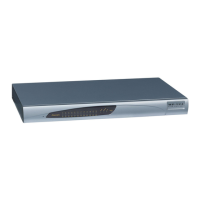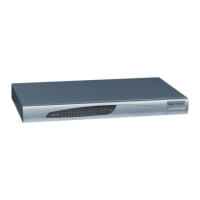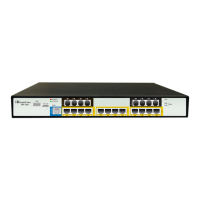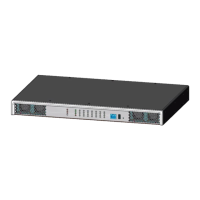Version 7.2 331 Mediant 1000B Gateway & E-SBC
User's Manual 17. Control Network
Parameter Description
assigned to the SIP Interface is applied first.
The parameter is applicable only to the SBC application.
Media
Media Realm
media-realm-name
[SIPInterface_MediaRealm]
Assigns a Media Realm to the SIP Interface.
By default, no value is defined.
To configure Media Realms, see ''Configuring Media Realms'' on
page 309.
Direct Media
intra-srd-media-anchoring
[SIPInterface_SBCDirectMedi
a]
Enables direct media (RTP/SRTP) flow (i.e., no Media Anchoring)
between endpoints associated with the SIP Interface.
[0] Disable = (Default) Media Anchoring is employed, whereby the
media stream traverses the device (and each leg uses a different
coder or coder parameters).
[1] Enable = No Media Anchoring. Media stream flows directly
between endpoints (i.e., does not traverse the device - no Media
Anchoring).
[2] Enable when Same NAT = No Media Anchoring. Media stream
flows directly between endpoints if they are located behind the
same NAT.
Note:
If the parameter is enabled for direct media and the two endpoints
belong to the same SIP Interface, calls cannot be established if
the following scenario exists:
a. One of the endpoints is defined as a foreign user (for
example, “follow me service”)
b. and one endpoint is located on the WAN and the other on the
LAN.
The reason for the above is that in direct media, the device does
not interfere in the SIP signaling such as manipulation of IP
addresses, which is necessary for calls between LAN and WAN.
To enable direct media for all calls, use the global parameter
SBCDirectMedia. If enabled, even if the SIP Interface is disabled
for direct media, direct media is employed for calls belonging to
the SIP Interface.
If you enable direct media for the SIP Interface, make sure that
your Media Realm provides sufficient ports, as media may
traverse the device for mid-call services (e.g., call transfer).
For more information on direct media, see Direct Media on page
616.
The parameter is applicable only to the SBC application.
Security
TLS Context Name
tls-context-name
[SIPInterface_TLSContext]
Assigns a TLS Context (SSL/TLS certificate) to the SIP Interface.
The default TLS Context ("default" at Index 0) is assigned to the SIP
Interface by default.
Note:
For incoming calls: The assigned TLS Context is used if no TLS
Context is configured for the Proxy Set associated with the call or
classification to an IP Group based on Proxy Set fails.
For outgoing calls: The assigned TLS Context is used if no TLS

